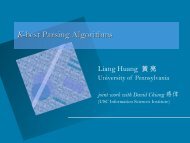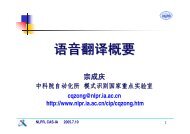Machine Translation with Lattices and Forests
Machine Translation with Lattices and Forests
Machine Translation with Lattices and Forests
Create successful ePaper yourself
Turn your PDF publications into a flip-book with our unique Google optimized e-Paper software.
Sys<br />
Avg # of Rules<br />
tokens links All dev&tst<br />
BLEU<br />
F 28.7 35.1 29.6M 3.3M 28.75<br />
LF 37.1 37.1 23.5M 3.4M 29.65<br />
Table 1: Results of forest (F) <strong>and</strong> lattice-forest<br />
(LF) systems. Please note that lattice-forest system<br />
only extracts 23.5M rules, which is only 79.4% of<br />
the rules extracted by forest system. However, in<br />
decoding step, lattice-forest system can use more<br />
rules after filtered on dev <strong>and</strong> test sets.<br />
pared <strong>with</strong> the characters-based lattice parsing, our<br />
most-refined lattice parsing speeds up parsing by<br />
(37.1/46.7) 3 ≈ 2 times, since parsing complexity<br />
is O(n 3 ).<br />
More interestingly, our lattice-forest model only<br />
extracts 23.5M rules, which is 79.4% percent of<br />
the rules extracted by the baseline system. The<br />
main reason lies in the larger average number<br />
of words for most-refined segmentations over lattices<br />
being 37.1 words vs 28.7 words over 1-best<br />
segmentations. With much finer granularity, more<br />
word aligned links <strong>and</strong> restrictions are introduced<br />
during the rule extraction step by GIZA++. However,<br />
more rules can be used in the decoding step<br />
for the lattice-forest system, since the lattice-forest<br />
is larger than the forest over 1-best segmentation.<br />
We also investigate the question of how often<br />
the non 1-best segmentations are picked in the final<br />
translation. The statistic on our dev set suggests<br />
33% of sentences choose non 1-best segmentations.<br />
So our lattice-forest model can do global<br />
search for the best segmentation <strong>and</strong> parse-tree to<br />
direct the final translation. More importantly, we<br />
can use more translation rules in the translation<br />
step.<br />
7 Related Works<br />
Compactly encoding exponentially many derivations,<br />
lattice <strong>and</strong> forest have been used in some<br />
previous works on SMT. To alleviate the problem<br />
of parsing error in 1-best tree-to-string translation<br />
model, Mi et al. (2008) first use forest to<br />
direct translation. Then Mi <strong>and</strong> Huang (2008) use<br />
forest in rule extraction step. Following the same<br />
direction, Liu et al. (2009) use forest in treeto-tree<br />
model, <strong>and</strong> improve 1-best system by 3<br />
BLEU points. Zhang et al. (2009) use forest in<br />
tree-sequence-to-string model <strong>and</strong> also achieve a<br />
promising improvement. Dyer et al. (2008) combine<br />
multiple segmentations into word lattice <strong>and</strong><br />
then use lattice to direct a phrase-based translation<br />
decoder. Then Dyer (2009) employ a single<br />
Maximum Entropy segmentation model to generate<br />
more diverse lattice, they test their model<br />
on the hierarchical phrase-based system. <strong>Lattices</strong><br />
<strong>and</strong> forests can also be used in Minimal Error<br />
Rate Training <strong>and</strong> Minimum Bayes Risk Decoding<br />
phases (Macherey et al., 2008; Tromble et al.,<br />
2008; DeNero et al., 2009; Kumar et al., 2009; Li<br />
<strong>and</strong> Eisner, 2009). Different from the works listed<br />
above, we mainly focus on how to combine lattice<br />
<strong>and</strong> forest into a single tree-to-string system.<br />
8 Conclusion <strong>and</strong> Future Work<br />
In this paper, we have proposed a lattice-forest<br />
based model to alleviate the problem of error propagation<br />
in traditional single-best pipeline framework.<br />
Unlike previous works, which only focus on<br />
one module at a time, our model successfully integrates<br />
lattice into a state-of-the-art forest tree-tostring<br />
system. We have explored the algorithms of<br />
lattice parsing, rule extraction <strong>and</strong> decoding. Our<br />
model postpones the disambiguition of segmentation<br />
<strong>and</strong> parsing into the final translation step, so<br />
that we can make a more global decision to search<br />
for the best segmentation, parse-tree <strong>and</strong> translation<br />
in one step. The experimental results show<br />
that our lattice-forest approach achieves an absolute<br />
improvement of +0.9 points in term of BLEU<br />
score over a state-of-the-art forest-based model.<br />
For future work, we would like to pay more<br />
attention to word alignment between lattice pairs<br />
<strong>and</strong> forest pairs, which would be more principled<br />
than our current method of word alignment between<br />
most-refined segmentation <strong>and</strong> string.<br />
Acknowledgement<br />
We thank Steve DeNeefe <strong>and</strong> the three anonymous<br />
reviewers for comments. The work is supported<br />
by National Natural Science Foundation<br />
of China, Contracts 90920004 <strong>and</strong> 60736014,<br />
<strong>and</strong> 863 State Key Project No. 2006AA010108<br />
(H. M <strong>and</strong> Q. L.), <strong>and</strong> in part by DARPA GALE<br />
Contract No. HR0011-06-C-0022, <strong>and</strong> DARPA<br />
under DOI-NBC Grant N10AP20031 (L. H <strong>and</strong><br />
H. M).









